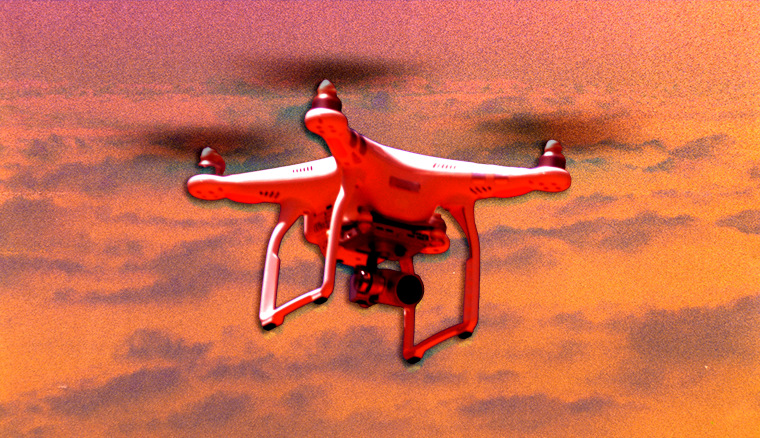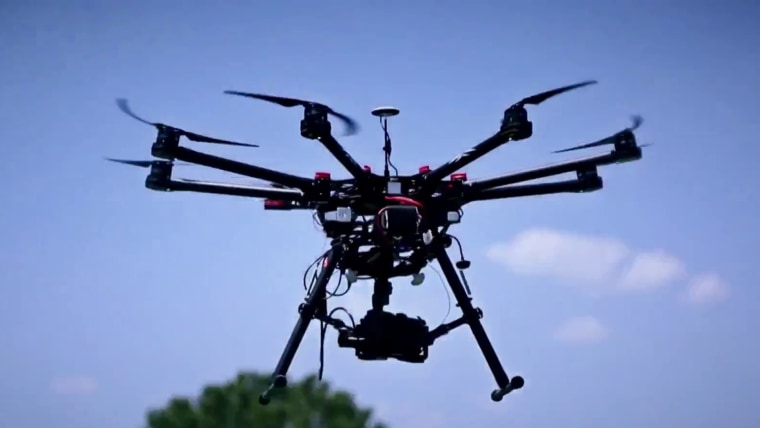U.S. tech companies prepare for potential drone attacks as international strikes spark concern

U.S. tech companies and government agencies are racing to develop defenses against potential terrorist drone attacks, a threat that has security experts increasingly concerned as they’ve watched the rise of drone warfare in Israel, Ukraine and Yemen.
Since Oct. 7, Israel and Hamas have used drones against each other in Gaza, including in a video released by Hamas appearing to show a small drone dropping an explosive on a squad of Israeli soldiers. Yemen’s Houthi rebels have used swarms of drones to target shipping in the Red Sea, launching at least 21 in one attack this month. And for months, Russia and Ukraine have been launching coordinated mass drone attacks at each other, with one Russian swarm in November numbering 75 drones.
The drones used in the attacks have often come in the form of small, remote-controlled aircraft popular among hobbyists. They’re either outfitted with a small explosive to be dropped on the target, or are simply crashed into a target as a self-detonating, one-way drone.
Now, dozens of tech companies are working on systems to thwart possible drone attacks, including within the U.S., where civilian sites might potentially be targeted, according to academics and industry analysts.
“The fact that we haven’t had any serious domestic incidents is a blessing and really comes as a surprise due to the potential impact,” said Jamey Jacob, an engineering professor at Oklahoma State University and director of the university’s Oklahoma Aerospace Institute for Research and Education.
Products in development in the drone defense sector range from communications-jamming equipment to guns that shoot rapidly expanding nets to experimental lasers. Some of these products are quietly going through testing sponsored by the Department of Homeland Security at remote sites in Oklahoma and North Dakota, and analysts expect demand to grow rapidly, with potential customers including police departments, airports and sports stadiums.
The companies working on drone countermeasures range from major defense contractors such as Raytheon and Lockheed Martin to tech startups producing “GPS spoofers” that convince a drone it’s somewhere else. Other products rely on concentrated microwave bursts to fry a drone’s electronics or hacking tools to take over a drone’s operation.
Jacob estimated there are at least 100 companies actively working in the sector.
“We probably aren’t even aware of all of them right now,” he said.
The anti-drone tech sector is known among insiders as counter-unmanned aircraft systems, or C-UAS. Bard College researchers found in a 2019 report that there was already major investment in the sector, with 277 manufacturers working on some type of drone countermeasures. A review by NBC News found that dozens are marketing products on their websites. DHS said that 33 U.S. and international companies responded to a procurement notice last year.
Some drone countermeasures, at least for detecting them, are already being deployed at airports in Europe, experts said. The Federal Aviation Administration has been testing systems at U.S. airports, too.
The Department of Homeland Security has tried to speed up the research into products and prototypes, forming partnerships with at least two universities — Oklahoma State and the University of North Dakota — to help evaluate different drone countermeasures.
Last summer, in what Jacob called a first-of-its-kind event, about a dozen companies were invited to demonstrate and test their drone-defense products at a dedicated facility just east of Oklahoma State’s campus in Stillwater. Jacob said they have sent a confidential scorecard to the DHS and they plan a second, similar event this year.
“As with every other industrial commercial product, claims don’t necessarily line up with how they do in the field,” Jacob said.
“What we essentially do is throw threats at that detection system and determine how well it works and what areas need to be improved upon,” he said.
An ideal system, he said, would not only detect and identify a drone but also defeat it if necessary by jamming its signals, disabling it or destroying it.
A separate, smaller round of testing took place last summer in North Dakota. Teams of researchers at the University of North Dakota tested four systems specifically on the potential for collateral damage when a hostile drone falls back to earth, said Mark Askelson, the university’s associate vice president for research in national security.
“If you crash an aircraft, there’s potential for fires, and if it’s a battery aircraft, it could be a battery fire,” he said.
The Biden administration has encouraged the push in the anti-drone sector in multiple ways, issuing a call last year for universities, private companies and other researchers to come up with fresh ideas to address the threat. The administration has also pushed for legislation to expand who can legally force down a drone — an authority that under current law is generally limited to federal agents. That legislation is pending in Congress.
While the specter of drone terrorism has been around for years, the wars in Israel, Ukraine and Yemen have added to the urgency by demonstrating how the technology has progressed.
“There’s been an explosion of interest because of the Ukraine war,” said Zachary Kallenborn, an adjunct fellow with the Center for Strategic and International Studies, a bipartisan policy organization in Washington.
Kallenborn and two other researchers wrote an academic paper in 2022 about terrorism involving multiple, coordinated drones — an idea they compared to a “plague of locusts.” Now, Kallenborn said that the prospect is getting closer as drones become cheaper, faster, better able to carry weapons and more autonomous.
By contrast, much of the security architecture built in the U.S. in the past 30 years was designed around preventing airplane hijackings like the Sept. 11 attacks or truck bombings like the 1995 attack on the Oklahoma City federal building.
“Putting bollards everywhere made sense at a time when terrorists were using car bombs,” Kallenborn said.
There’s already been at least one likely attempt at a drone attack within the U.S.: In July 2020, someone sent a drone over a Pennsylvania power substation with the likely intent of short-circuiting the electric grid, according to an intelligence bulletin reported by ABC News. The attempt failed, and no one has been charged.
Since then, federal preparations have ramped up. In 2022, the White House released a plan for countering domestic drone threats including the creation of a database to track incidents, the founding of an anti-drone training center, and the proposed expansion of legal authority so that state and local law enforcement — or even power plant operators, potentially — are allowed to shoot down drones in certain circumstances.
But federal resources haven’t matched the demand for protection. The Wall Street Journal reported last month that although the DHS gets thousands of requests a year from event organizers who want drone protection, it grants “only a few dozen.” The newspaper also said the FBI has only three agents dedicated to drone defense.
In a statement to NBC News, the FBI did not say how many agents it has working on drone threats. The FBI said it has “an experienced team of headquarters-based agents and professional staff solely dedicated” to countering drone threats, and that the headquarters agents work closely with FBI field offices and other government agencies “to ensure the US government efficiently maintains its defensive posture with regard to UAS.”
A DHS spokesperson said that the department was working to release more specific information about requests from event organizers. Resources are limited, she said, and the focus is on high-risk events. Anti-drone coverage at events increased 22% in 2023, according to the department.
DHS authority for detecting and taking down drones flying illegally in U.S. airspace has also been at risk of expiring, possibly as soon as Feb. 3, without further congressional action.
“We have to have the capability to defend against the adverse use of drones,” Homeland Security Secretary Alejandro Mayorkas said at an event last year.
At the local level, the New York Police Department has announced its use of drone countermeasures at major events such as the U.S. Open.
Sports leagues are among those pushing for protection.
“The unauthorized use of drones (whether malicious or otherwise) presents a significant and rising threat to all large gatherings of people, including major sporting events,” the NFL, MLB, NCAA and NASCAR said in a joint letter to Congress last year. They want local police to have authority to shoot down or disable drones flying illegally.
There have been thousands of close calls where drone pilots presumably didn’t intend to cause a collision. There were 2,300 incidents at airports alone over a recent two-year period, often causing flight delays, according to the DHS.
A California man was charged and pleaded guilty after he used a drone to drop leaflets over two NFL games in 2017. People have been charged criminally with flying drones too close to a local fire station in Virginia and a Coast Guard helicopter. A recurring issue is drone deliveries of contraband to prisons.
And in 2015, a small drone crashed on the White House lawn after a federal employee who was operating it several blocks away lost control of the device, causing a temporary lockdown.
But none of those was a determined attack aimed at terrorizing civilians.
Bryan Stern, a former Navy SEAL who’s now a security consultant, said that domestic drone defense will look a lot different from systems that the U.S. military is buying to protect the armed forces from drone attacks at home and abroad. One military system from Anduril Industries, named Roadrunner, is in effect a mini autonomous fighter jet.
“What are you going to do? Take M16 machine guns and start hosing down the sky?” Stern said. “You can do that if you’re in the U.S. Navy in the middle of the Red Sea. You’re not doing that in Alexandria, Virginia,” he said. He said he has conducted training sessions for law enforcement on how to respond to possible terrorist drone attacks.
But there would also be downsides to putting drone defense systems at every sports stadium, concert venue, government building, power station and other sensitive sites, experts said.
“It could actually be quite harmful to release the beast and have radio frequency jammers everywhere,” Kallenborn said, noting that such devices can disrupt radio communications across a wide area.
Michael German, a former FBI special agent who’s now a fellow at the Brennan Center for Justice, a civil liberties organization, said he questioned the need for law enforcement to have new authority to take down drones, or the need to have expensive new defense systems when it’s still impossible to say how likely a drone terrorist attack is.
“We have to be careful about how we’re empowering the government,” he said. “It’s very easy to scare the public with hypotheticals and then implement policies that actually do more harm than good.”
German said a more immediate threat is people using cars and trucks to hit civil rights demonstrators. That happened 104 times during the summer 2020 protests after the murder of George Floyd in Minneapolis, according to USA Today — a number that German called “astonishing.”




No comments:
Post a Comment